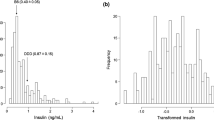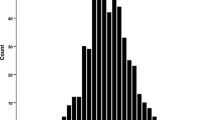Abstract
Inbred DDD/Sgn mice are heavier than inbred C57BL/6J mice. In the present study, we performed quantitative trait loci (QTL) mapping for body weight using R/qtl in reciprocal F2 male populations between the two strains. We identified four significant QTL on Chrs 1, 2, 5, and 17 (proximal region). The DDD/Sgn allele was associated with increased body weight at QTL on Chrs 1 and 5, and the DDD/Sgn allele was associated with decreased body weight at QTL on Chrs 2 and 17. A multiple regression analysis indicated that the detected QTL explain 30.94 % of the body weight variation. Because DDD/Sgn male mice have extremely high levels of circulating testosterone relative to other inbred mouse strains, we performed QTL mapping for plasma testosterone level to examine the effect of testosterone levels on body weight. We identified one suggestive QTL on Chr 5, which overlapped with body weight QTL. The DDD/Sgn allele was associated with increased testosterone level. Thus, we confirmed that there was a genetic basis for the changes in body weight and testosterone levels in male mice. These findings provide insights into the genetic mechanism by which body weight is controlled in male mice.





Similar content being viewed by others
References
Bhasin S, Woodhouse L, Storer TW (2003) Androgen effects on body composition. Growth Horm IGF Res 13:S63–S71
Bouchard C, Pérusse L (1994) Genetics of obesity: family studies. In: Bouchard C (ed) The genetics of obesity. CRC Press, Boca Raton, pp 79–92
Broman KW, Sen Ś (2009) A guide to QTL mapping with R/qtl. Springer, New York
Broman KW, Wu H, Sen Ś, Churchill GA (2003) R/qtl: QTL mapping in experimental crosses. Bioinformatics 19:889–890
Corona G, Vignozzi L, Sforza A, Mannucci E, Maggi M (2015) Obesity and late-onset hypogonadism. Mol Cell Endocrinol 418:120–133
Falconer DS, Mackay TFC (1996) Introduction to quantitative genetics, 4th edn. Longman, Essex
Goto N, Nakajima Y, Imamura K, Yoshida T (1985) Influence of testosterone on hydronephrosis in the inbred mouse strain DDD. Lab Anim 19:85–88
Kim JH, Stewart TP, Zhang W, Kim HY, Nishina PM, Naggert JK (2005) Type 2 diabetes mouse model TallyHo carries an obesity gene on chromosome 6 that exaggerates dietary obesity. Physiol Genomics 22:171–181
Kojima M, Degawa M (2013) Serum androgen level is determined by autosomal dominant inheritance and regulates sex-related CYP genes in pigs. Biochem Biophys Res Commun 430:833–838
Kojima M, Sekimoto M, Degawa M (2010) Androgen-mediated down-regulation of CYP1A subfamily genes in the pig liver. J Endocrinol 207:203–211
Lander E, Kruglyak L (1995) Genetic dissection of complex traits: guidelines for interpreting and reporting linkage results. Nat Genet 11:241–247
Lin H-Y, Xu Q, Yeh S, Wang RS, Sparks JD, Chang C (2005) Insulin and leptin resistance with hyperleptinemia in mice lacking androgen receptor. Diabetes 54:1717–1725
Masaki T, Chiba S, Yoshimichi G, Yasuda T, Noguchi H, Kakuma T, Sakata T, Yoshimatsu H (2003) Neuronal histamine regulates food intake, adiposity, and uncoupling protein expression in agouti yellow (A y/a) obese mice. Endocrinology 144:2741–2748
Purcell-Huynh DA, Weinreb A, Castellani LW, Mehrabian M, Doolittle MH, Lusis AJ (1995) Genetic factors in lipoprotein metabolism. J Clin Investig 96:1845–1858
Suto J (2008) Genetic dissection of testis weight in a mouse strain having an extremely large testis: major testis weight determinants are autosomal rather than Y-linked on the basis of comprehensive analyses in Y-chromosome consomic strains. Proc Jpn Acad B 85:393–406
Suto J (2011) Quantitative trait loci that control body weight and obesity in an F2 intercross between C57BL/6J and DDD.Cg-A y mice. J Vet Med Sci 73:907–915
Suto J (2013a) QTL mapping of genes controlling plasma insulin and leptin concentrations: metabolic effect of obesity QTLs identified in an F2 intercross between C57BL/6J and DDD.Cg-A y inbred mice. J Vet Med Sci 75:895–907
Suto J (2013b) Y chromosome of the inbred mouse KK/Ta strain is associated with reduced body size in Y-consomic strains. BMC Res Notes 6:64
Suto J, Matsuura S, Imamura K, Yamanaka H, Sekikawa K (1998) Genetic of obesity in KK mouse and effects of the A y allele on quantitative regulation. Mamm Genome 9:506–510
Wuschke S, Dahm S, Schmidt C, Joost HG, Al-Hasani H (2007) A meta-analysis of quantitative trait loci associated with body weight and adiposity in mice. Int J Obes 31:829–841
Acknowledgments
This study was supported in part by the NIAS Strategic Research Fund.
Author information
Authors and Affiliations
Corresponding author
Electronic supplementary material
Rights and permissions
About this article
Cite this article
Suto, Ji., Kojima, M. Quantitative trait loci that control body weight in DDD/Sgn and C57BL/6J inbred mice. Mamm Genome 28, 13–19 (2017). https://doi.org/10.1007/s00335-016-9666-3
Received:
Accepted:
Published:
Issue Date:
DOI: https://doi.org/10.1007/s00335-016-9666-3




